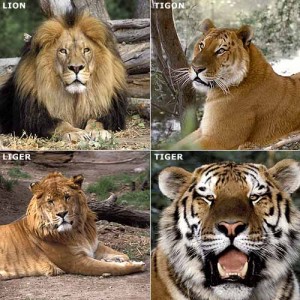In desperate attempt to perpetuate the illusion that complex biological novelty can easily emerge in the biosphere, Darwinists have resorted to defining species in a way that allows new “species” to emerge with ease. They argue members of a species become new species when they lose the ability or incentive to interbreed, even when no significant novelty is involved.
Here is a true statement:
emergence of radically different and new organs would imply no interbreeding
but the converse is not true even though it is promoted by Darwinists as if it were true:
no interbreeding implies emergence of radically different and new organs
For example, see how this university website advertises newly acquired inability as macroevolution: Speciation. Individuals of a species that get geographically isolated evolve to be nominally different and eventually may lack desire or ability to mate. They call this process allopatric speciation. At times individuals of a species may share the same geographic area and then for some reason stop mating (such as emergence of polyploidy), this is called sympatric speciation. All well and fine, and I can even accept that as “speciation”, but I draw the line when they label it macro evolution or insinuate similar mechanisms induce macro evolution. Such as suggested by wiki:
Contrary to claims by creationists, macro and microevolution describe fundamentally identical processes on different time scales.
http://en.wikipedia.org/wiki/Macroevolution
To understand how Darwinists resorted to equivocation and hasty generalizations to “prove” their points, let me provide an illustration. Suppose someone took a set of cars and hit them with paintballs and sledgehammers and said:
I’ve created a new variety of cars.
Paintballs and sledgehammers induce change over time in materials, and change over time is required to create cars, and since I’ve demonstrated change over time with paint balls and sledgehammers, I’ve demonstrated how easily new cars are manufactured from raw materials into cars.
This assertion has logical fallacy on many levels – hasty generalization, a non-sequitur, equivocation, vague meanings, etc. Evolutionary theory is founded on analogous fallacies.
Like the “speciation” of new cars via paintballs and sledgehammers, emergence of one kind of change (like inability or lack of desire to interbreed) does not necessarily imply emergence of other kinds of change (such as radical new organs).
Let’s say for sake of argument allopatric and sympatric speciation create new species. Is this evolution of new body plans and systems (like bat sonar) as promoted by evolutionists? No. This would be like someone saying paintballs and sledgehammers are the way car engines, brakes, ignition systems, spark plugs, lights, and cruise controls, etc. are manufactured from raw materials. Silliness!
And problematic in this line of definition is that it leads to all sorts of paradoxes at the individual (not population) level. For example, when Frank Sinatra and Ava Gardner split up, did that create a new set of species? Here is their compelling tale: The sexual volcano: Ava Gardner was the one lover Sinatra couldn’t tame…and when she spurned him, he slit his wrist in despair .

http://www.sevenreflections.com/images/people/Ava_Gardner_Frank_Sinatra.jpg
Evolutionists will say, “speciation is not an individual process but a population process, so Frank Sinatra and Ava Gardner are inappropriate examples”. Fine! The paradox doesn’t go away because here are examples of species emerging via population processes (either allopatric or sympatric, it doesn’t matter) millions of years ago only to be found to have the ability to interbreed in the present day:

http://24.media.tumblr.com/tumblr_lx00i4ZeZu1r0mlb9o1_500.jpg
The species of tiger (which may be as old as 35 million years) can interbreed with the species of lion (which may be as old as 1 million years) and create a Tigon or Liger. So in approximately the time scale (5 million years) needed to evolve 20 unique animal phyla in the Cambrian explosion, we have something like the Panthera genus (tigers, lions, leopards, jaguars) that diversifies so slightly that the members can still interbreed!
Do we then de-originate the species lion and tiger species back into the Panthera genus? Some Darwinists might even say the hybrid tigons and ligers are new species! But aren’t these distinctions arbitrary? And even if true, what relevance do arguments about what defines a species have with respect to evolution of radical new organs?
There are novelties that the lion and tiger have, but for that matter every human has novelties that no other human has, and if they are sufficiently extraordinary we refer to such individuals as gifted, but we don’t view them as a new species.
These instances of hybridization at the very least show the slow process that may sometimes be involved in creation of a new “species” via isolation. Hence, we have evolutionists having to admit an embarrassing fact:
we can’t (except in a very few cases) see a new species arise.
In fact, one might reasonably assert we’ve never seen a new species arise in the present day except by their newly acquired inability or refusal to interbreed. This admits the possibility that the origin of real novelty (like bat sonar and wings arising in bat ancestors) is by processes other than those directly observed in operation today.
For sure there are other diversifications in a species that look like new species. For example Brassica oleracea are species that has diversified through farming that the descendants of the ancestors look like different species:
Brassica oleracea is the species of plant that includes many common foods as cultivars, including cabbage, broccoli, cauliflower, kale, Brussels sprouts, savoy, and Chinese kale.

http://images.sciencedaily.com/2010/07/100707223231-large.jpg
But is this disproof of special creation? No. It only proves some degree of change happens, but not the sort of change that would cause serious doubt of creation such as radical new organs, body plans, or physiology. And since ID permits common descent and front loading, such cases of diversification don’t disprove ID.
Contrary to popular perception, similar levels of change have been known and observed and recorded and explained by creationists and ID proponents even before Darwin. Darwin’s 1859 book essentially plagiarized the idea of natural selection from the creationist Blyth who wrote in 1836 and 1837:
When two animals are matched together, each remarkable for a certain given peculiarity, no matter how trivial, there is also a decided tendency in nature for that peculiarity to increase; and if the produce of these animals be set apart, and only those in which the same peculiarity is most apparent, be selected to breed from, the next generation will possess it in a still more remarkable degree; and so on, till at length the variety I designate a breed, is formed, which may be very unlike the original type.
Blyth 1836
It is a positive fact, for example, that the nestling plumage of larks, hatched in a red gravelly locality, is of a paler and more rufous tint than in those bred upon a dark soil. May not, then, a large proportion of what are considered species have descended from a common parentage?
Blyth 1837
Was Blyth True Scientist and Darwin Merely a Plagiarist and Charlatan
But Blyth correctly observed that variation had limits, a fact which Darwin did not disprove:
often modified in the extremes, till the general aspect has become entirely changed, but still retaining, to the very ultimate limits, certain fixed and constant distinctive characters
Blyth
Which describes well real evolution in the wild such as allopatric and sympatric “speciation”, evolution of anti-biotic resistance, etc. And it goes in opposition Darwin’s inflated claims of macro evolution where fish evolve into birds and bats.
Finally, even with regard to speciation, evolutionists admit Darwin was wrong:
What’s clear, though, is that Darwin’s theory of speciation (in which populations were simply riven in two by selection) wouldn’t work.
and in literature Accidental Origin of Species
Everywhere you look in nature, you can see evidence of natural selection at work in the adaptation of species to their environment. Surprisingly though, natural selection may have little role to play in one of the key steps of evolution – the origin of new species. Instead it would appear that speciation is merely an accident of fate.
NOTES:
1. http://en.wikipedia.org/wiki/Phylum

2. I pointed out other ridiculous equivocations and rhetorical ploys by Darwinists here:
Death of the Fittest
Selection falsely called a mechanism when instead it should be labeled an outcome